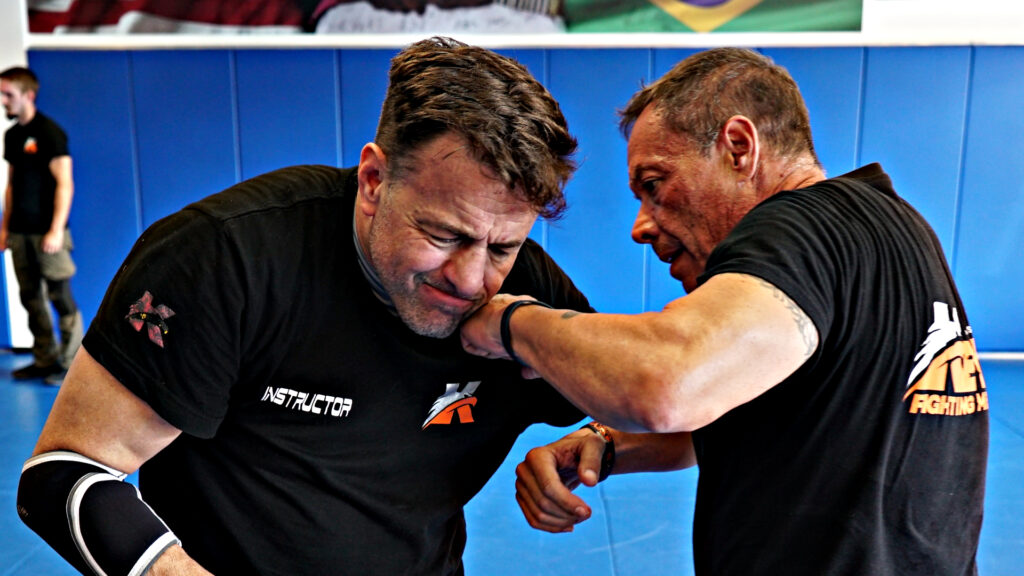
In the realm of self-defense, the scenario of facing multiple opponents is a complex and often contentious subject. Traditional training methods typically focus on one-on-one encounters, leaving a significant gap when it comes to dealing with multiple attackers. This gap in training is not just a tactical deficiency; it’s a critical vulnerability that needs addressing.
The standard advice of “lining them up” — maneuvering so you only have to face one attacker at a time — is a strategy based on the idea of managing and minimizing the threat. While this concept has its merits, it’s often easier said than done in the chaotic reality of a physical confrontation. Moreover, this strategy might not be feasible in confined spaces or situations where attackers are coordinated.
Expanding on this concept, Keysi Fighting Methods (KFM) introduces a more nuanced approach with its four-man prison drill. This drill is a dynamic and practical way to simulate the stress and confusion of being surrounded. Placing practitioners in the middle of a human square forces them to reckon with threats from all directions. It’s not just about fighting off multiple attackers; it’s about understanding spatial awareness, managing fear, and making rapid, strategic decisions under pressure.
The drill works like this: four partners surround you, each within an arm’s reach, representing potential threats from every side. The proximity is crucial — it’s the distance at which a strike is not just possible but probable. From this position, you engage with various techniques to understand how a move, like a basic jab or cross, would work against an assailant from any direction. The objective isn’t just to practice these techniques but to dissect them, understand their mechanics, and adapt them to a 360-degree threat environment.
It’s crucial to understand that the 4-man box drill is precisely what it’s termed: a “DRILL.” Its purpose extends beyond routine practice; it’s crafted to challenge your conventional thought processes, provoke inquiries that might not typically arise, and illuminate aspects of training that might have previously been overlooked. This drill isn’t just about physical maneuvering; it’s a strategic tool designed to expand your tactical thinking and enhance your overall self-defense and situational awareness approach.
This kind of training is about expanding your tactical vocabulary. It’s one thing to throw a punch or a kick in a controlled dojo setting against a single, cooperative partner. It’s another to navigate and neutralize a threat that could come from any angle at any moment. The four-man prison drill forces you to confront the limitations of your training and seek ways to overcome them.
KFM’s philosophy, born from the harsh realities of urban street confrontations and the personal history of its founder, Justo Diéguez, emphasizes a holistic approach. Diéguez’s upbringing in a small, tough mining town in Spain shaped his understanding of violence and the need for practical self-defense. The mines were a place of brutality and fear, where failing to defend oneself had dire consequences. This environment fostered a mindset not just of survival but of proactive defense — an understanding that one must be prepared for anything.
The core of KFM and the guiding principle in Diéguez’s teachings is the development of instinct. It’s about more than just physical techniques; it’s about cultivating an intuitive understanding of violence and how to counter it. KFM’s movements and principles aren’t confined by the traditional boundaries of martial arts styles. They are fluid, adaptable, and rooted in the universal laws of motion and human behavior.
A central concept in KFM and my own training philosophy is the principle of 360 degrees of destructive force. This idea is a litmus test for any technique: Can it deliver effective force in any direction without the need to adjust stance or orientation significantly? If a technique falls short, it’s a prompt to explore, adapt, and evolve until it meets this criterion. This principle isn’t just theoretical; it’s a practical, applied part of training programs I’ve developed and implemented across the United States, particularly in tactical and law enforcement contexts.
In real-world confrontations, the luxury of time and space is rare. You won’t always have the opportunity to position yourself ideally or focus on a single threat. You might be dealing with an assailant in front while another approaches from behind. The situation is far from ideal, but it’s a reality that must be addressed. Dismissing it without seeking effective countermeasures is a disservice to the practitioner.
Training for multiple opponents, therefore, isn’t just about physical preparation. It’s about mental and emotional readiness. It’s about cultivating a mindset that refuses to accept defeat or complacency. It’s about the relentless pursuit of improvement and understanding that the path of a warrior is one of constant learning and adaptation.
In conclusion, facing multiple opponents in a real-world scenario is a daunting challenge, but it’s not insurmountable. It requires a shift from traditional, linear fighting concepts to a more holistic, adaptable approach. Programs like KFM and drills like the four-man prison offer valuable frameworks for this kind of training. They push you to expand your tactical awareness, adapt your techniques, and, most importantly, evolve your mindset. The goal is to survive and thrive in the face of overwhelming odds, turning what was once a weakness into a testament of strength, resilience, and unyielding will.
I frequently receive inquiries about KFM, as I oversee the system in the US and manage the instructors’ program. Should you need more information on the system, please don’t hesitate to contact me anytime.

Alan Baker is celebrated for his exceptional skill in creating customized Defensive Tactics Programs and his prowess in high-performance coaching. Tailoring his expertise to meet the needs of law enforcement agencies, military groups, and security companies, Alan crafts training curriculums that are grounded in practical techniques, adaptability to real-life scenarios, and intensive, situation-specific exercises. His training methodologies are meticulously designed to elevate the operational effectiveness and situational preparedness of individuals in high-stakes environments. Learn more about Alan’s distinctive programs here.
Beyond his tactical acumen, Alan is also a foremost “mindset” coach, adept at tapping into the untapped potential within individuals. He is particularly attuned to the current societal trend that often overlooks traditional masculinity and the cultivation of strength. Addressing this, Alan champions the development of a warrior spirit — the readiness to confront chaos and take decisive action when necessary. He passionately mentors professionals, entrepreneurs, and individuals on their personal development journeys, focusing on fostering a mindset dedicated to excellence. His coaching is anchored in pragmatic strategies that fortify mental resilience, enhance focus, and stimulate drive. Engaging with Alan sets you on a transformative journey where mental obstacles are overcome, innate strengths are recognized and honed, and your objectives become distinctly attainable. His insights are key in boosting performance and developing a mindset geared for victorious accomplishments.
For a deeper exploration of Alan’s mindset philosophy and his approach to empowering especially men to embrace their strength and resilience, delve into his insightful collection of books. If you’re ready to accelerate your personal and professional growth under Alan’s expert guidance, connect through his official website.

